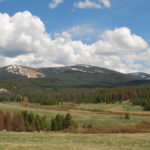When will environmental litigants be held accountable?
Posted: September 7, 2017Source: Healthy Forests.org
Note: This column by Ed Regan originally appeared in the Independent-Record.

Both the Park Creek and Arrastra Fires on the Helena-Lewis and Clark National Forest were ignited by lightning storms that spread through dense stands of dead timber. And both are located within the area of the Forest Service’s proposed Stonewall Vegetation Project, which was halted when two environmental litigant groups successfully convinced a federal judge to issue a preliminary injunction to halt the project.
In the face of significant forest health concerns on the Helena-Lewis and Clark National Forest, the Stonewall project was initially proposed as far back as 2010. The Forest Service recognized that action was needed to respond to mountain pine beetle outbreaks, and the forest should be managed to maintain and improve viable mature habitat structure to support big game and other wildlife. The agency determined that treatments on unnaturally overgrown stands would promote resiliency with a mosaic of species, reduce fire hazard, and potentially provide timber products to support Western Montana jobs. All of these proposed actions are supported by science.
The Stonewall project included recommendations from the collaborative Lincoln Restoration Committee, consisting of local government officials, conservationists, and timber industry representatives. The collaborative agreed to a combination of logging and prescribed burning to accomplish the goals of the project.
Two serial litigants, the Alliance for the Wild Rockies and the Native Ecosystems Council, did not participate in the collaboration. Instead, they sued the Forest Service claiming that the forest management activities and road densities would endanger Canada lynx and grizzly bears under the Endangered Species Act, even though the proposed action has been found to comply with the ESA by the U.S. Fish and Wildlife Service.
Unfortunately, the court cited the Cottonwood case as a precedent, which required the Forest Service to reinitiate ESA consultation with the U.S. Fish and Wildlife Service on a decades-old land management plan, as opposed to the actual proposed projects where such consultations commonly occur – and which did happen with the Stonewall Project. Because forest planning is an exhaustive process that often takes decades to revise, the nonsensical Cottonwood decision threatens to upend years of work to design projects that address the threats of catastrophic wildfire, insects and disease.
Both of Montana’s U.S. Senators, Steve Daines and Jon Tester, have introduced bipartisan legislation to address the Cottonwood case and allow the Forest Service to address the threats to our national forests. Their legislation simply codifies the Obama Administration’s position that the federal agencies are not required to reinitiate consultations at the forest planning level. Congress should pass this legislation without delay, because as many as 80 vegetation management projects are threatened by Cottonwood.
The preliminary injunction against the Stonewall project, and the resulting fires on the Helena-Lewis and Clark are just the latest examples of our broken federal land management system. How many more forested acres must get destroyed, and how many more lives and properties must be endangered before environmental litigant groups are held accountable for their actions?
